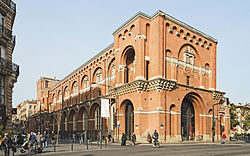Musée des Augustins

The Musée des Augustins de Toulouse seen from Rue d'Alsace Lorraine
|
|
| Established | 31 August 1801 |
|---|---|
| Location | Toulouse, France |
| Coordinates | 43°36′04″N 1°26′46″E / 43.601000°N 1.446000°E |
| Type | Fine arts |
| Director | Axel Hémery |
| Website | http://www.augustins.org/home |
The Musée des Augustins de Toulouse is a fine arts museum in Toulouse, France which conserves a collection of sculpture and paintings from the Middle Ages to the early 20th century. The paintings are from throughout France, the sculptures representing Occitan culture of the region with a particularly rich assemblage of Romanesque sculpture.
The building in which the museum is sited was built in 1309 in the Gothic style and prior to the French Revolution housed Toulouse's Augustinian convent. The convent was secularized in 1793 and first opened to the public as a museum on 27 August 1795 by decree of the French Convention, very shortly after the opening of the Louvre, making it one of the oldest museums in France after the Louvre. It at first housed the Muséum Provisoire du Midi de la République and the école des Beaux-Arts.
The Musée des Augustins de Toulouse was one of fifteen museums founded in provincial centres, by a decree of 13 Fructidor year IX (31 August 1801), which was promulgated by the minister of the interior, Jean-Antoine Chaptal (Arrêté Chaptal du 14 fructidor an IX). At the start of the 19th century several medieval buildings (notably the refectory) were demolished and in their place Viollet-le-Duc and his pupil Darcy put up new exhibition galleries, accessed by a Gothic Revival monumental stair offering an interplay of richly complicated vaulting systems. The works continued from 1873 to 1901, when the museum reopened. In effect, Toulouse commissioned Urbain Vitry to ensure remove all the convent's religious characteristics. The archaeologist Alexandre du Mège occupied the cloister and rebuilt it to be able to house the medieval collections gathered from Toulouse's destroyed religious buildings such as the basilique Saint-Sernin. Today the cloister houses a reconstructed medieval garden. The building was classed as a Monument historique in 1840.
...
Wikipedia

